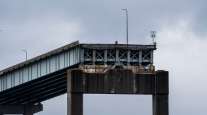Staff Reporter
Tutorials, Updated Datasets Among Upgrades Planned for FHWA Bridge Portal

[Stay on top of transportation news: Get TTNews in your inbox.]
The Federal Highway Administration will introduce tutorial videos, fix bugs and update datasets as part of a series of enhancements to its web portal that offers a wealth of data on bridges.
Known as InfoBridge, the portal offers a centralized source of performance data to users. Through its mapping tool, people can locate bridges nationwide and view information such as their length and the year they were built. InfoBridge is a component of FHWA’s Long-Term Bridge Performance Program, a research effort authorized by Congress under the Safe, Accountable, Flexible, Efficient Transportation Equity Act: A Legacy for Users.
Jean Nehme, leader of FHWA’s Long-Term Infrastructure Performance team, discussed the enhancements planned for this year during a session at the Transportation Research Board’s annual meeting Jan. 27.

Nehme speaks at the virtual event. (Screengrab via Transportation Research Board)
Nehme explained there are no barriers to participation in InfoBridge; anyone in the world can use the portal.
“It is our hope, as the Federal Highway Administration, that our program will facilitate tools and product development by others, resulting in multiplying efforts by many folds,” Nehme said.
Additionally, FHWA plans to host a workshop to gather input from bridge experts to assist the agency in assessing the program’s future data collection approach. Participants likely will include FHWA representatives, academics, state department of transportation officials and industry members. Nehme noted it has been about a decade since the Long-Term Bridge Performance Program held a workshop for subject matter experts to discuss its approach to data collection.
“Technology has evolved, additional research has been conducted [and] stakeholders’ needs have changed,” Nehme said. “Our intent is to host a workshop that will build on previous work that was undertaken by the program over the years and help us assess our current data collection approach and provide us with feedback that may help us achieve the program goals.”
Data on bridges plays an important role in the bridge inspection process. Glenn Washer, an engineering professor at the University of Missouri, compared inspection intervals to doctor visits.
“When the bridge is young and in good condition, you don’t go to the doctor very much,” Washer said. “When the bridge gets old, just like us, it needs to go to the doctor more. So it’s going to have a shorter inspection interval.”
Jose Matos, a professor at the University of Minho in Portugal, said the presence of heavy trucks on bridges is one of the main factors that affects deterioration, and inspection frequency should be adjusted accordingly for structures that bear freight vehicles.

Matos
Washer describe the practice of risk-based inspection, which refers to the analysis process used to determine a suitable inspection interval. It considers aspects such as the reliability of bridge elements and the consequences of damage. He noted that an unnecessary inspection presents an unnecessary risk, as it will involve an inspector working on a roadway, which can be unsafe.
“You want to be able to focus your inspection resources, which are a finite size for most bridge owners, on where the needs are greatest,” Washer said. “If you can focus your inspections where they’re needed the most, then you can improve the quality of inspections.”
Want more news? Listen to today's daily briefing:
Subscribe: Apple Podcasts | Spotify | Amazon Alexa | Google Assistant | More




